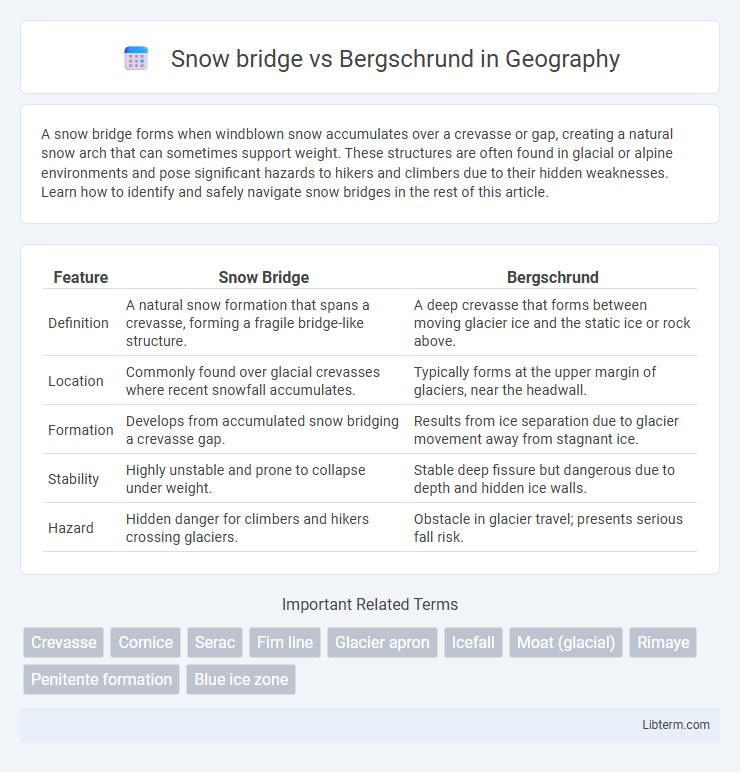A snow bridge forms when windblown snow accumulates over a crevasse or gap, creating a natural snow arch that can sometimes support weight. These structures are often found in glacial or alpine environments and pose significant hazards to hikers and climbers due to their hidden weaknesses. Learn how to identify and safely navigate snow bridges in the rest of this article.
Table of Comparison
| Feature | Snow Bridge | Bergschrund |
|---|---|---|
| Definition | A natural snow formation that spans a crevasse, forming a fragile bridge-like structure. | A deep crevasse that forms between moving glacier ice and the static ice or rock above. |
| Location | Commonly found over glacial crevasses where recent snowfall accumulates. | Typically forms at the upper margin of glaciers, near the headwall. |
| Formation | Develops from accumulated snow bridging a crevasse gap. | Results from ice separation due to glacier movement away from stagnant ice. |
| Stability | Highly unstable and prone to collapse under weight. | Stable deep fissure but dangerous due to depth and hidden ice walls. |
| Hazard | Hidden danger for climbers and hikers crossing glaciers. | Obstacle in glacier travel; presents serious fall risk. |
Introduction to Snow Bridges and Bergschrunds
Snow bridges form when snow accumulates and consolidates over crevasses, creating a fragile, often hidden passage that can support weight temporarily. Bergschrunds are deep, persistent crevasses that develop between moving glacier ice and the stationary ice or rock above, marked by vertical walls and significant depth. Understanding the formation and characteristics of snow bridges and bergschrunds is crucial for glacier navigation and mountaineering safety.
Formation Processes: Snow Bridge vs Bergschrund
A snow bridge forms when accumulated snow layers span crevasses or gaps in glacier surfaces, creating a fragile, often temporary crossing. In contrast, a bergschrund develops due to glacier movement where the ice pulls away from the stagnant ice or rock above, forming a deep crevasse that separates the moving glacier from the mountain slope. While snow bridges result from seasonal snow deposition and compaction, bergschrunds form through dynamic glacier fracturing and ice flow tension.
Physical Characteristics and Appearance
A snow bridge is a natural arch of compacted snow that forms over a crevasse, often appearing as a smooth, white surface blending seamlessly with the glacier's snowfield. Bergschrunds are large, jagged cracks at the upper head of a glacier, characterized by deep, exposed ice walls and irregular, fractured edges. While snow bridges are fragile and temporary, bergschrunds are more stable and prominent features marking the boundary between moving glacier ice and stagnant snow.
Common Locations on Glaciers
Snow bridges commonly form over crevasses in the accumulation zones of glaciers where fresh snow conceals deep cracks, making them prevalent near the glacier's upper sections. Bergschrunds typically appear at the junction between the moving glacier ice and the stagnant ice or firn above, often located near the glacier's headwall or steep cirques. Both features are crucial in glaciology for identifying hazard zones but differ in position, with snow bridges covering crevasses and bergschrunds marking the glacier's uppermost fissures.
Risks and Dangers Associated with Each
Snow bridges pose significant risks as they can collapse under the weight of climbers, leading to falls into hidden crevasses beneath the snow. Bergschrunds, large crevasses often found at the head of a glacier, present hazards due to their deep, often unstable ice walls that can be difficult to navigate and prone to sudden icefalls. Both features require specialized knowledge and equipment to traverse safely, as misjudging their stability can result in serious injury or fatalities.
Role in Glacier Travel and Mountaineering
Snow bridges form over crevasses by accumulated snow layers, presenting hidden pathways that require careful evaluation to avoid collapse during glacier travel. Bergschrunds are large, typically persistent crevasses that separate moving glacier ice from stagnant ice or the headwall, serving as critical barriers in mountaineering routes. Understanding the formation and stability differences between snow bridges and bergschrunds is essential for safe navigation and risk assessment on glaciers.
Detection and Assessment Techniques
Detecting a snow bridge involves visual inspection for surface cracks and using ground-penetrating radar (GPR) to assess snow depth and integrity, as these structures often conceal crevasses beneath snow accumulation. Bergschrund identification relies on optical methods such as high-resolution photography and aerial drone surveys to detect the large crevasse that forms between moving glacier ice and the stagnant ice or rock above. Both features are further evaluated through ultrasonic sensors and thermal imaging to determine stability and potential hazards for mountaineers and glaciologists.
Survival Strategies: Crossing Safely
Snow bridges form over crevasses, presenting fragile, often deceptive surfaces that require careful probing and balanced weight distribution to cross safely. Bergschrunds, large crevasse-like gaps between moving glacier ice and stagnant ice, demand cautious route selection and rope team techniques to prevent falls. Utilizing proper glacier travel gear like crampons, ice axes, and securing rope anchors enhances survival chances when navigating these icy obstacles.
Impact on Climbing Routes and Expeditions
Snow bridges create hidden dangers on climbing routes by concealing crevasses, increasing the risk of falls and requiring careful route assessment and rope team travel. Bergschrunds, large crevasse-like gaps between moving glacier ice and stagnant snow, often form challenging obstacles that can slow progress and necessitate technical climbing skills or detours. Both features significantly impact expedition planning, demanding precise navigation strategies to avoid accidents and ensure successful ascent or descent.
Conclusion: Key Differences and Precautions
Snow bridges are temporary ice or snow formations that cover crevasses and pose a hidden hazard for climbers, while bergschrunds are persistent, large crevasse openings formed by the separation of moving glacier ice from stagnant ice above. Understanding the stability and location of snow bridges is critical to avoid accidents, as they can collapse under weight, whereas bergschrunds often require technical climbing skills to navigate safely. Proper assessment of snow bridge thickness and continuous monitoring of bergschrund conditions are essential precautions in glacier travel and mountaineering.
Snow bridge Infographic

 libterm.com
libterm.com